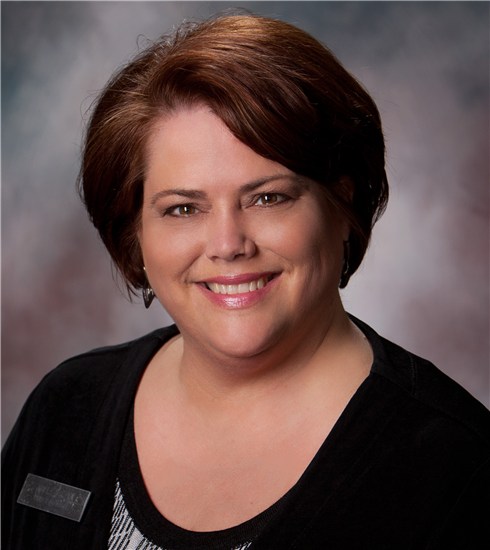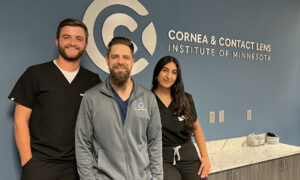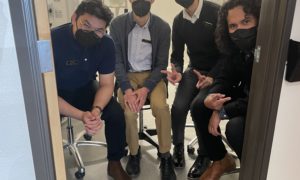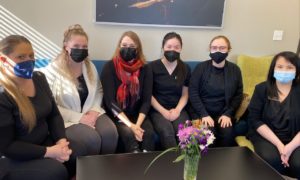By Elaine Happ, OD, and Melonie Carlson, CPOA

Elaine Happ, OD
Hire employees according to baseline qualifications, then trainthem to maximize their potential. This pays off in the superior service they can provide.
If an OD could choose her ideal employees, they all would have previous experience working in an optometric setting. However, as most of us know, that is rarely the case. Most of our employees have proven work experience, but often in another industry–sometimes solely in retail. For that reason, we often hire our employees based on the potential we think they have to excel in serving our patients, rather than based on similar previous experience. Here is how my office takes raw talent and potential and hones it to provide superior service that suits our patients’ needs.
Hire Right
Hire Based on Attitude
Our experience in hiring is that it is best to always choose attitude over experience since most prospective employees have never worked in optometry. That means training a new employee who may know nothing about what we do. Our practice is in a bedroom community of Minneapolis. We are about 45 minutes away and most people–a mix ranging from working class to upper-middle-class–commute. There is also still some farming in the area.

Melonie Carlson, CPOA
With such a diverse mix of people, we notice not just the applicant’s work experience and references, but how they present themselves during the interview. We notice if they smile and laugh easily and how easy they are to interact with. Does the prospective employee just stare stone-faced as we talk, or does he nod his head, smile and interject points of interest? If he interacts easily with us that tells us there is a good chance he will be able to handle pleasantly interacting with patients. We also notice the person’s attitude when asked about his willingness to do tasks.
For instance, if we let him know that there is a certain amount of clerical work that will be expected and he pauses for a long time and then says: “Well, I guess that would be OK,” we have been given a red flag. On the other hand, if the applicant smiles and says immediately: “No problem. Actually, that might work out well because that will give me a chance to better understand your back-office operations,” we know we may have a winner.
Train Thoroughly
Develop Training Policy
We do a combination of online education, job shadowing and one-on-one training. We pay employees for both their time as well as for the cost of the course.
Provide Multifaceted Training
One mode of training isn’t enough to turn that employee with the promising attitude and raw skills into a high-functioning optometric employee. So, we rely on several different training modalities. We do a combination of online education, job shadowing and one-on-one training.
The online component might consist of continuing education modules that can be completed online or a webinar, while job shadowing could entail following one of our best employees throughout a work day. One-on-one training can be as simple as the employee who offers the job shadowing also sitting down before the office opens or at the end of the day–or whenever time permits–to review lessons learned or explore a task more in-depth that was only touched on during the shadowing process. For example, if during job shadowing, the employee was introduced to our practice management system, then the new staff member also would need some one-on-one time in front of the computer to understand enough to use the system on her own.
Webinars are usually offered in one-hour sessions with several different time slots. We have used those offered by insurance companies for extra training for our billing staff, while the technicians take advantage of the ones offered by contact lens manufacturers, and those featuring new lens technology are usually attended by those who work in the optical dispensary. These training sessions are coordinated by each team leader so all interested staff has a scheduled time to attend. Employees are paid to do this training since they usually do these sessions before or during their regular shifts.
The vast majority of our training is done on-site and is paid at the employee’s regular pay rate. Doing this results in a temporary increase in labor costs. We spend at least $20,000 annually on employee training. The results are worth the cost when you consider the damage done by a staff member who does not serve patients well causing some to leave the practice.
Encourage Self-Learning
Much of the training that we offer staff is not mandatory. It is made clear to staff members that the effort they put into educating themselves will be taken into consideration during performance reviews. We have recently switched to basing increases on performance. Previously,we werein the habit of granting pay increases simply because an employee was here for another year. Attendance at continuing education events plays a large part in the value of what a staff member can bring to Uptown Eye Care.
Invest in Live, In-Person Training, CE Events
Our biggest continuing education event of the year is the Minnesota Optometric Association’s annual meeting. This is a two-day event that the staff looks forward to each year. Attendance is optional, but we do pay staff their usual wages for time spent in classes. If there are some staff members who do not wish to attend, we keep the office open. Needless to say, most choose to go to the conference. We pay all registration fees, hotel expenses for those taking classes both days and mileage/parking reimbursement for those who carpool. Meals are provided as part of the registration for the event. This event is the most costly education event for the practice, with the investment totally between $6,000 to $9,000, depending on the number of staff that enroll. It averages to approximately $500 per employee. A bonus to meetings like this is the team-building aspect. It gives our staff members a chance to visit with one another outside of the office.
We consider this to be an investment in the practice. When you consider the cost of lens remakes when the wrong lens is chosen for a patient or measurements are taken incorrectly, the cost of using doctor time for an Rx check when perhaps a simple frame adjustment would solve a problem, the time saved during an exam when pre-testing and contact lens evaluations are handled by a well-trained assistant and, most significantly, the cost of losing a patient who feels their needs were not met, then the cost of registration fees and labor costs are small in comparison.
Optimize Membership in Optometric Alliances
Optometric alliances have greatly increased their emphasis on providing staff training. As a member of the Vision Source network, we have access to online webinars and tests that cover all areas of the optical clinic, from how to answer the telephone to billing medical insurances to skills needed for optical dispensing. Staff members are assigned a login and password so they have access to this resource. Vendor partners also sponsor education throughout the year, with the highlight a one-day education event that the entire staff attends in the fall. This is the one other day during the year that we close the office for continuing education.
Organize Live Events of Your Own
Occasionally, we have after-hours education provided by a doctor in our practice. Mary Gregory, OD, does the InfantSee exams in our office, and one evening we invited staff from surrounding offices to attend a short seminar on how this type of exam is done and how technicians can assist the doctor. Since attendance was optional, staff was not paid for attending the event. We did, however, provide dinner for those who came. The paraoptometric section of the Minnesota Optometric Association also schedules similar seminars several times throughout the year.
Our optical manager also plans field trips for new staff members. Two of the optical labs that we use are within driving distance and they welcome the chance to give tours of their facilities. We have found it very beneficial for new opticians to see how lenses are manufactured and they get many of their questions answered during these trips.
Tap Specialized Expertise
Identify Your Star Employees–and Leverage Their Knowledge
We have found that some people have natural abilities when it comes to teaching and communicating information. These are the staff members we try to use to teach new employees. In some cases this would be the team leader in a department, but not always. It is also beneficial to schedule time for the trainer to train. It only wears out good staff members to expect them to take the time to explain everything they are doing to the new staff member and still keep up their usual pace in caring for patients.
Just as we pay new employees for the time required for training, we also pay employees for the training they provide if it requires them to spend additional hours in the office. The attention you paid to attitude when hiring new employees must also be paid to those whom you choose to conduct training. Having a high-level of competency is not enough, the trainers also must have a positive attitude in general and a positive attitude specifically toward the training process.
Just because an employee has a positive attitude toward patients and other staff members during day-to-day work doesn’t mean they will have the right disposition and patience needed to be a quality trainer. Observe trainers the first time they do training and see how well the interaction between trainer and new employee goes. Once the training is complete, ask the new employee what he thought of the training process with the trainer you selected, and, most essential of all, observe the results of the training. How well is this new employee functioning on-the-job? Is he mixing up eyeglasses orders and mistreating patients? Is he incorrectly inputting data into your computer systems? To assess whether your training, and a specific trainer, has been effective, you must monitor the outcome carefully.
Tap Vendor Expertise
Many of our vendor partners provide excellent resources that we optimize. Essilor has created a training program for new dispensers through their ECP University. It is a combination of online training, a workbook with in-office assignments and a coach’s guide. We have successfully used this for at least four new employees since it was introduced. Our practice management/EHR software also provides online training modules that we like to use.
There is no shortage of resources for this type of training. We find our lab/vendor reps are more than willing to come into our office to train staff in their particular area of expertise. Usually this is done over lunch periods. The vendors generously bring lunch for everyone, and staff members stay on the clock since they are receiving training as they eat their meals. We never close the office for this type of training, we just have some staff continue to care for patient needs during this typically quieter part of the day.
Measure Training Effectiveness
Ask Your Patients and Staff Members How Well You Have Trained Staff
Both patient satisfaction surveys and internal employee surveys are useful indicators of where additional training may be needed. We use DemandForce for patient communication, and our office manager carefully monitors the surveys and online reviews. The most productive way to use these surveys is to post the positive feedback we get, especially ones that mention staff members by name. When staff members hear what patients appreciate about their visit it encourages everyone to mirror that behavior.
Internal surveys are often verbal, usually voiced during team meetings. Recently, our technicians realized they were each performing and recording cover tests and near point convergence tests differently. They requested some clarification on the correct way to perform the test, and one of the doctors instructed the technician team trainer who then spent time with each technician to demonstrate the proper technique.
Related ROB Articles
Optometric Alliances: A Primary OD and Staff Education Tool
Executive Review: Assess and Improve Practice Performance
Staff Performance Booster Shots: Continuously Evaluate Progress and Review Annually
Elaine Happ, OD, is the owner of Uptown Eye Care in Monticello, Minn. To contact her: ehapp@uptowneyecare.com.
Melonie Carlson, is office manager at Uptown Eye Care. To contact her: melonie.carlson@uptowneyecare.com.



























